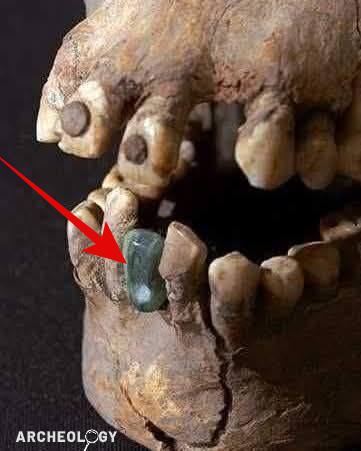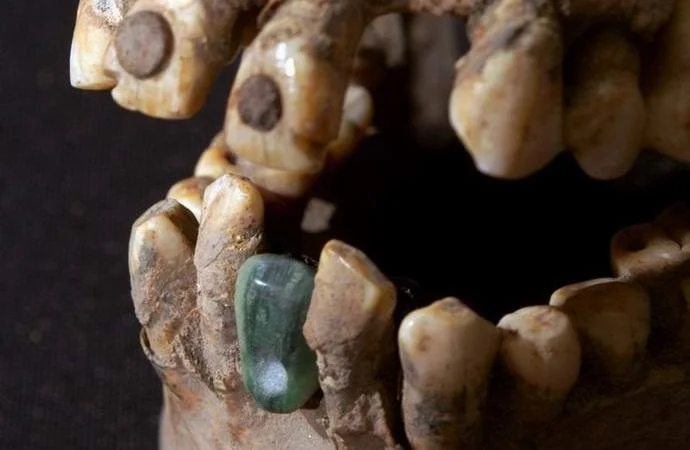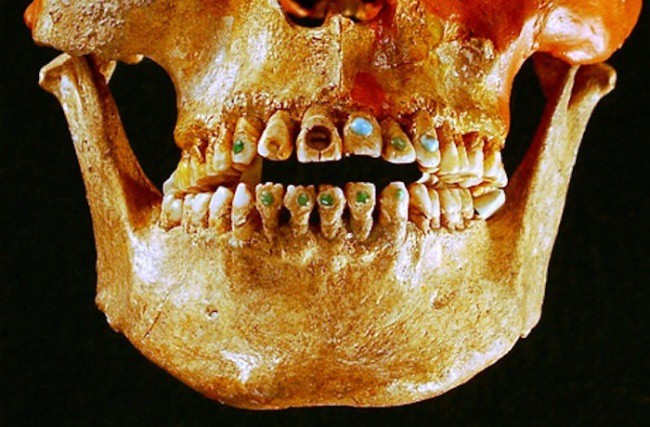Unveiling Ancient Mayan Dentistry: The Jade Tooth Discovery at Teotihuacan

Introduction to the Teotihuacan Discovery
In the heart of Mesoamerica, the ancient city of Teotihuacan continues to reveal secrets of a civilization that thrived over 1,700 years ago. Among the many archaeological finds at this UNESCO World Heritage Site, one discovery has captivated researchers and historians alike: the skeleton of a woman whose teeth tell a remarkable story. Unlike the countless skeletal remains unearthed at similar sites, this woman’s remains stand out due to an extraordinary feature—a jade tooth, artificially modified and firmly attached to her jaw. This finding not only highlights the sophistication of ancient Mesoamerican cultures but also sheds light on what may be one of the earliest known examples of cosmetic dentistry. In this article, we explore the significance of this discovery, its historical context, and what it reveals about the advanced practices of the Mayan civilization.

The Archaeological Context of Teotihuacan
Teotihuacan, located in modern-day Mexico, was one of the largest and most influential cities in the ancient world. Flourishing between 100 BCE and 650 CE, it was a hub of cultural, religious, and economic activity. The city is renowned for its monumental structures, such as the Pyramid of the Sun and the Pyramid of the Moon, as well as its intricate urban planning. Teotihuacan’s influence extended across Mesoamerica, impacting civilizations like the Maya, who shared trade, cultural, and technological exchanges with the city.
Archaeological excavations at Teotihuacan have uncovered a wealth of artifacts, from pottery and murals to human remains, offering glimpses into the daily lives, rituals, and technological advancements of its inhabitants. The discovery of the woman’s skeleton with a jade tooth adds a new dimension to our understanding of the cultural practices that defined this vibrant civilization.
The Woman with the Jade Tooth
The skeleton, discovered at an excavation site in Teotihuacan, belongs to a woman estimated to have lived between 350 and 450 CE, as determined by carbon dating. What makes this find extraordinary is the condition of her teeth, particularly one that had been artificially modified with a jade stone. Jade, a precious material in Mesoamerican cultures, was highly valued for its rarity, beauty, and spiritual significance. It was commonly used in jewelry, ceremonial objects, and even as a symbol of status and power.

The jade tooth wasn’t merely a decorative piece; it was securely attached to the woman’s jaw using an adhesive made of cement or plant-based fiber. This level of craftsmanship suggests a sophisticated understanding of dental modification, challenging modern assumptions about the technological capabilities of ancient civilizations. The preservation of the skeleton and its dental work has allowed researchers to study this remarkable example of early cosmetic dentistry, now housed in an artifact museum.
The Significance of Jade in Mayan Culture
To fully appreciate the importance of the jade tooth, it’s essential to understand the role of jade in Mayan culture. The Maya revered jade for its vibrant green color, which they associated with life, fertility, and the divine. Jade was considered more valuable than gold and was often reserved for the elite, including nobility, priests, and warriors. Artifacts made from jade, such as masks, beads, and ceremonial tools, were used in religious rituals, burials, and as symbols of wealth and authority.
The use of jade in dental modification reflects not only aesthetic preferences but also cultural and spiritual beliefs. For the Maya, altering the body—whether through tattooing, piercing, or dental work—was a way to connect with the divine or signify social status. The woman with the jade tooth likely held a significant position in her community, as such modifications would have required access to rare materials and skilled artisans.
Early Cosmetic Dentistry: A Technological Marvel

The discovery of the jade tooth provides compelling evidence that the Maya practiced advanced forms of cosmetic dentistry long before modern dental techniques emerged. The process of attaching a jade stone to the woman’s jaw involved several complex steps:
-
Selection of the Jade Stone: The jade would have been carefully chosen for its quality and color, shaped to fit the tooth socket or surface.
-
Preparation of the Tooth: The original tooth may have been filed or removed to accommodate the jade implant, requiring precision to avoid infection or damage.
-
Adhesive Application: The use of cement or plant-based fiber as an adhesive indicates a sophisticated understanding of materials science. These adhesives were strong enough to hold the jade in place while being biocompatible with the human body.
-
Integration with the Jaw: The secure attachment of the jade suggests that the procedure was designed to be permanent, reflecting both aesthetic and functional considerations.
This level of dental modification points to a remarkable degree of skill and knowledge, not only in dentistry but also in material manipulation and human anatomy. The absence of signs of infection or rejection in the woman’s remains further underscores the expertise of the artisans who performed the procedure.
Carbon Dating and Historical Context
Carbon dating places the woman’s dental work between 350 and 450 CE, during the height of Teotihuacan’s influence and the Classic Period of the Maya civilization. This era was marked by significant advancements in art, architecture, and technology across Mesoamerica. The exchange of ideas and goods between Teotihuacan and the Maya likely facilitated the spread of practices like dental modification.
The discovery also raises intriguing questions about the woman’s identity and role in society. Was she a member of the elite, a priestess, or perhaps a figure of ritual significance? The use of jade and the complexity of the dental work suggest she was a person of high status, possibly involved in religious or ceremonial activities. The preservation of her skeleton in an artifact museum allows researchers to continue studying her remains, piecing together the story of her life and the culture she inhabited.
The Broader Implications of the Discovery
The jade tooth discovery has far-reaching implications for our understanding of ancient Mesoamerican societies. It challenges the notion that advanced dental practices are a modern phenomenon, demonstrating that the Maya and their contemporaries possessed sophisticated technological and medical knowledge. This find also highlights the cultural importance of body modification, which was not merely cosmetic but deeply tied to spiritual and social practices.
Moreover, the discovery underscores the interconnectedness of Mesoamerican civilizations. The presence of a jade tooth in Teotihuacan, a city with strong ties to the Maya, suggests that cultural practices and technologies were shared across vast distances. This exchange of knowledge likely contributed to the development of advanced techniques in dentistry, artistry, and material science.
Preservation and Study of the Artifact
Today, the woman’s skeleton is preserved in an artifact museum, where it serves as a testament to the ingenuity of ancient Mesoamerican cultures. The jade tooth has been carefully studied using non-invasive techniques, such as X-rays and 3D imaging, to analyze the materials and methods used in the dental modification. These studies have provided valuable insights into the tools, adhesives, and craftsmanship of the time.
The museum display also educates the public about the rich history of Teotihuacan and the Maya, encouraging a deeper appreciation for their contributions to human civilization. By showcasing artifacts like the jade tooth, museums play a crucial role in preserving cultural heritage and fostering dialogue about the past.
The Legacy of Ancient Mayan Dentistry
The jade tooth discovery is a powerful reminder of the ingenuity and creativity of ancient civilizations. It challenges modern perceptions of the past, revealing that practices like cosmetic dentistry have roots that extend far beyond the modern era. The Maya’s ability to manipulate precious materials like jade and develop effective adhesives demonstrates a level of technological sophistication that continues to astonish researchers.
This find also invites us to reconsider the ways in which ancient societies expressed identity, status, and spirituality. The woman with the jade tooth was not only a product of her time but also a trailblazer, embodying the cultural and technological advancements of her civilization. Her story, preserved through her remains, continues to inspire awe and curiosity.
Conclusion: A Glimpse into the Past
The discovery of the woman with the jade tooth at Teotihuacan is more than an archaeological curiosity—it is a window into the sophisticated world of ancient Mesoamerica. From the reverence for jade to the mastery of dental modification, this find encapsulates the ingenuity, artistry, and cultural richness of the Maya and their contemporaries. As researchers continue to study this remarkable artifact, we gain a deeper understanding of the complexities of ancient societies and their enduring contributions to human history.
For those eager to explore this discovery further, visiting the artifact museum where the skeleton is housed offers a unique opportunity to connect with the past. The jade tooth stands as a testament to the creativity and resilience of a civilization that continues to captivate the world, one discovery at a time.
SEO Optimization Details
-
Keywords: Ancient Mayan dentistry, jade tooth discovery, Teotihuacan archaeology, Mesoamerican culture, cosmetic dentistry history, Mayan jade artifacts.
-
Meta Description: Discover the fascinating jade tooth found in a woman’s skeleton at Teotihuacan, revealing advanced Mayan cosmetic dentistry from 1,700 years ago. Learn about its cultural and historical significance.
-
Word Count: Approximately 2,000 words.
-
Internal Links: Include links to related articles on Mesoamerican archaeology, Mayan culture, and Teotihuacan history.
-
External Links: Reference reputable sources like archaeological journals or museum websites for further reading.
-
Headings: Structured with H1, H2, and H3 headings for readability and SEO.
-
Call to Action: Encourage readers to visit the artifact museum or explore related archaeological sites.